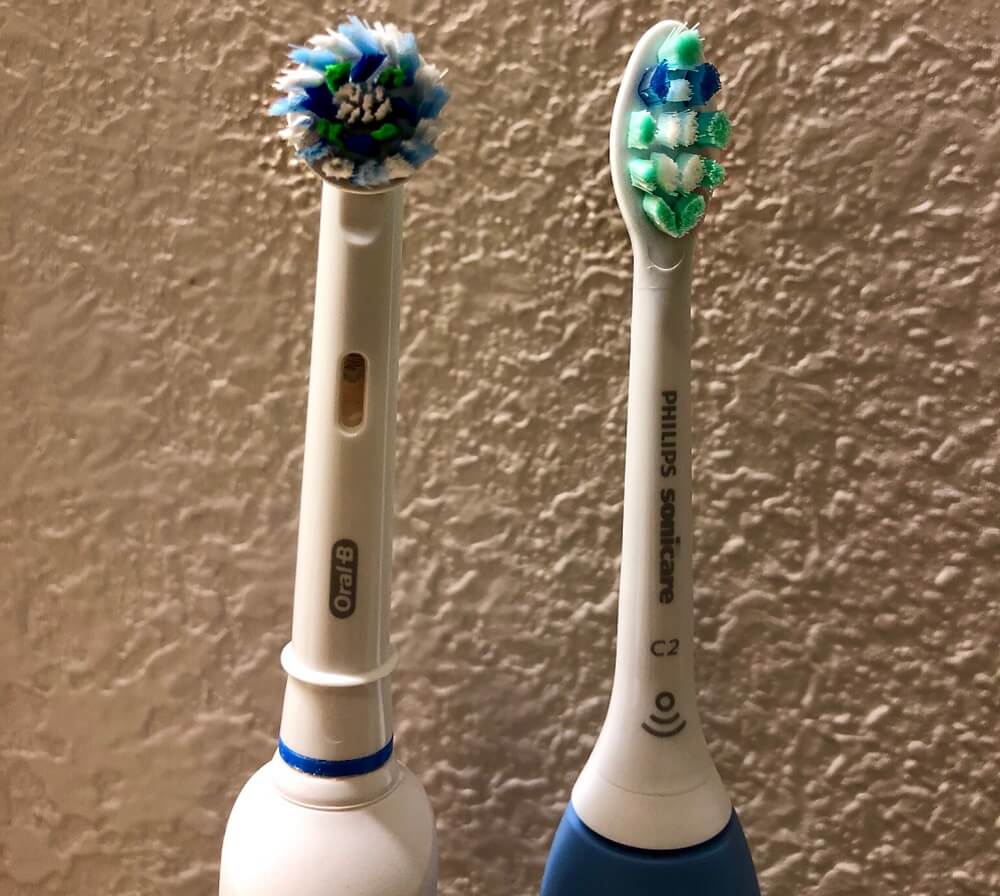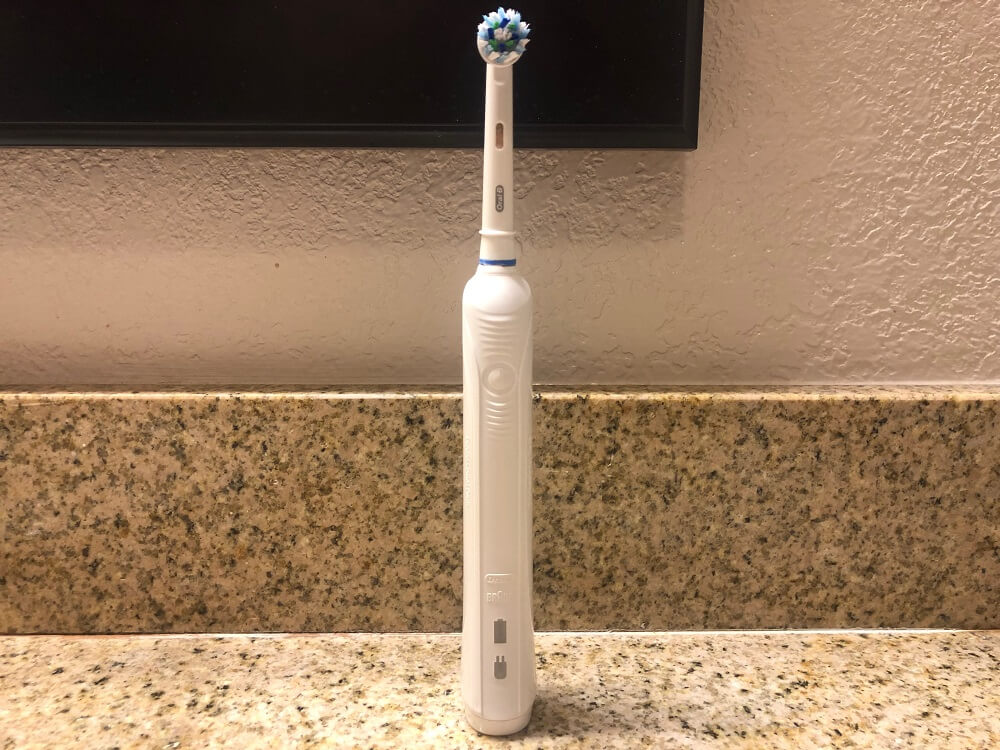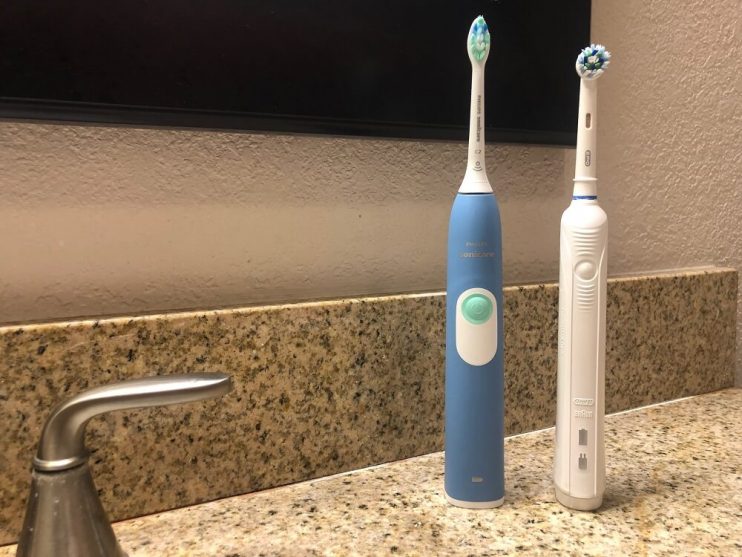If you’re reading this article, you probably already know the importance of brushing your teeth. However, we are here to inform you on the importance of choosing the right electric toothbrush. Electric toothbrushes aren’t anything new, but they have improved greatly over time and are recommended over a regular toothbrush by almost every dentist. The high frequency vibrations of electric toothbrushes enable a deeper and more thorough cleaning in less time than a regular toothbrush. So, which electric toothbrush is the best?
Table of Contents
Why We Chose Oral-B and Philips Sonicare
Oral-B and Philips Sonicare electric toothbrushes are the two most popular and highly recommended brands of the electric toothbrush realm. Due to the rave reviews, dentist recommendations, and vast array of models, it was a no-brainer to put these two brands against each other.
Rather than test every single toothbrush model of each brand, we decided to test the mid-range model for each brand – Oral-B Pro 1000 and the Philips Sonicare 2 Series. Both of these models sell for between $40-$60, and in our experience have been solid performers in the electric toothbrush space.
Pricing
The Oral-B Pro 1000 electric toothbrush is slightly cheaper than the Philips Sonicare 2 Series. The Oral-B comes in at around $40, whereas the Philips Sonicare comes in closer to $50.
Another important aspect of pricing is the cost of replacement brush heads. You can find cheap knock-off branded replacement brush heads for each toothbrush, but we do recommend buying the genuine brands as they have proven to be better quality than the knock-offs. The Oral-B Pro 1000 replacement brush heads cost around $12-$15 for a 3-pack, while the Philips Sonicare 2 Series replacement brush heads cost around $25 for a 3-pack. This is a huge difference in cost, and the clear winner here is Oral-B.
WINNER: Oral-B Pro 1000
- Clinically proven superior 3D cleaning oscillates and pulsates to break up and remove up to 300 percentage more plaque along the gum line than a regular manual toothbrush
- The pressure sensor stops the pulsation movement if you brush too hard and the in handle timer helps you brush for a dentist recommended 2 minutes
- 1 Mode, Daily Clean, rotates to break up and sweep away plaque
Features and Specifications
| Oral-B Pro 1000 | Philips Sonicare 2 Series | |
| Pricing | $38-45 | $45-50 |
| Battery Life | 7 Days | 14 Days |
| Pulses per Minute | 20,000 | 31,000 |
| Timer/Alert | 30 Second Timer 2 Minute Alert | 2 Minute Auto-Off |
| Pressure Sensing | ✔ | |
| ADA Approved | ✔ |
Design
Both brushes look very similar, but the Oral-B is lighter has a slimmer handle that we preferred. The grip was more natural in our hands while brushing, while the Philips Sonicare had a thicker handle that became slimmer towards the top.
Charging/Battery Life
The Oral-B and Philips Sonicare are both rechargeable electric toothbrushes that come with charging “stands” to stand the toothbrushes upright. They both feature a battery life indicator that lets you know when the toothbrush is out of juice. Oral-B claims a charge will last up to 7 days, assuming you brush your teeth twice a day for two minutes each session. Philips Sonicare claims that its charge will last up to 14 days. With our testing, neither toothbrush consistently reached those claims, but the Philips Sonicare clearly outlasted the Oral-B in terms of battery life. The Philips Sonicare is the clear winner here.
Performance Features
The purpose of an electric toothbrush is to perform the pulses for you, so you don’t have to manually move the toothbrush. Each brand here measures its pulsations in a 1 minute time frame. The Oral-B Pro 1000 has 20,000 pulsations per minute (or 8,800 complete rotations), while the Philips Sonicare 2 Series has 31,000 pulsations per minute. It sounds like the Philips Sonicare would be better since it has about 50% more pulsations per minute than the Oral-B, but it’s hard to say which is truly better since the Philips is a vibration pulse whereas the Oral-B is a rotational pulse.
Smart Features
The Oral-B Pro 1000 has a 30 second timer that vibrates to let you know to move on to cleaning the next quadrant of your mouth. It also has a vibration alert that lets you know when you have brushed your teeth for a full recommended two minutes.
The Philips Sonicare 2 Series has a two minute timer as well, but in this case it automatically turns the toothbrush off rather than giving you a vibrating alert.
One additional feature of the Oral-B Pro 1000 is a pressure sensor that is built in. If you brush too hard, the power level of the toothbrush will automatically be reduced so you don’t “overbrush” and damage your gums. This is a very neat feature that we really enjoyed.
The Philips Sonicare 2 Series has a unique “easy-start” feature. This feature gradually increases the power over your first 14 sessions to get new users acclimated to an electric toothbrush (as often manual toothbrush users may not be used to the power level in the beginning).
Approvals
The Oral-B Pro 1000 is approved by the American Dental Association (ADA), whereas the Philips Sonicare 2 Series is not. We don’t know how much weight to give this approval, but if it makes you sleep better at night knowing your toothbrush is ADA approved, choose the Oral-B!
How We Tested
To test each toothbrush, we had our reviewers use each toothbrush for a week, and then switch to the opposite toothbrush for the following week. We paid close attention to the feel of the toothbrush, ease of use, feeling after brushing, and various other details to give you a sense of which toothbrush will work best for you.
Brush Heads and Vibration

As you probably know, both the Oral-B and Philips Sonicare use rapid vibration to get a deep clean. The main difference between these two electric toothbrushes is their vibration method and their brush heads.
The Oral-B electric toothbrush utilizes a revolving toothbrush head, making the vibrations translate into circular rotating vibrations. Additionally, the brush head is shaped in a circle, and is the perfect size for the average tooth. This felt very effective at cleaning the surface area of our teeth and allowed us to get the brush head very close to our gums without actually hitting our gums.
The Philips Sonicare on the other hand, has no revolving toothbrush head, so the entire brush head vibrates (not just the very end like the Oral-B). The brush head is not circular, but rather it is the more traditional oval shape. We noticed that the brush head was abnormally skinny as well. This type of vibration coupled with the skinny brush head made it significantly more difficult to get the entire surface area of our teeth. However, this vibration was definitely more effective at cleaning between our teeth. Additionally, because the entire brush head vibrates, several of our reviewers noted that the Philips Sonicare toothbrush would vibrate their entire face and caused tickling sensations.
WINNER: We preferred the Oral-B Pro 1000’s circular brush head and rotating vibrations. It allowed us to better clean the surface of our teeth and didn’t cause uncomfortable tickling sensations.
- Clinically proven superior 3D cleaning oscillates and pulsates to break up and remove up to 300 percentage more plaque along the gum line than a regular manual toothbrush
- The pressure sensor stops the pulsation movement if you brush too hard and the in handle timer helps you brush for a dentist recommended 2 minutes
- 1 Mode, Daily Clean, rotates to break up and sweep away plaque
After Brush Feeling
Surprisingly, there was a huge difference in the way our mouths felt after brushing with each toothbrush. The Oral-B made our teeth feel cleaner than the Philips Sonicare. But the Sonicare made our gums and the rest of our mouths feel cleaner. Both felt good in their own way, and our team was perfectly split 50/50 on which after brush feeling they preferred.
WINNER: Tie
Best Electric Toothbrush

While both of these electric toothbrushes are great options, we have to give the title of the Best Electric Toothbrush to the Oral-B Pro 1000. Oral-B cleaned our teeth very well and was easy to place the brush head exactly where we wanted it. Although it doesn’t clean in between teeth as well as the Sonicare did, a good floss and mouthwash regime should more than make up for that deficiency. In addition, the Oral-B had features that matched those of the Philips Sonicare 2 Series, had cheaper replacement brush heads, and overall was more comfortable to use.
- Clinically proven superior 3D cleaning oscillates and pulsates to break up and remove up to 300 percentage more plaque along the gum line than a regular manual toothbrush
- The pressure sensor stops the pulsation movement if you brush too hard and the in handle timer helps you brush for a dentist recommended 2 minutes
- 1 Mode, Daily Clean, rotates to break up and sweep away plaque
Final Thoughts
You can’t go wrong with either electric toothbrush here. They are both great value toothbrushes that can drastically elevate your brushing experience. A great toothbrush can only get you so far though, we definitely recommend using floss, a good mouthwash, and a quality toothpaste!



